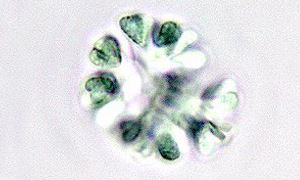These organisms can exist either as solitary floating cells or they can cluster together within a surrounding matrix. Unlike some organisms, they do not have a clear differentiation between their top and bottom structures. In certain instances, they create spherical colonies with a radial filamentous arrangement. These colonies can take on a spherical, nearly spherical, or somewhat irregular shape, and they might contain smaller sub-colonies that develop into daughter colonies. The cells are elongated along the radial axis and are found at the tips of branching stalks. The cells have an obovate shape, but they remain partially connected for a portion of their life cycle, resulting in a distinct heart-like appearance. Importantly, there is always a noticeable gap between neighboring individual or paired cells.
